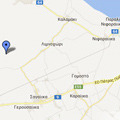Pheasants
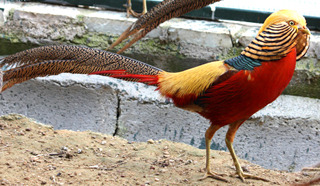 |
Golden PheasantThe Golden Pheasant or "Chinese Pheasant", (Chrysolophus pictus) is native to forests in mountainous areas of western China but feral populations have been established in the United Kingdom and elsewhere. The adult male is 90-105 cm in length, its tail accounting for two-thirds of the total length. It is unmistakable with its golden crest and rump and bright red body. Both males and females have yellow legs and yellow bills. Despite the male's showy appearance, these hardy birds are very difficult to see in their natural habitat, which is dense, dark young conifer forests with sparse undergrowth. Although they can fly in short bursts they are quite clumsy in flight and spend most of their time on the ground. Golden Pheasants lay 8-12 eggs at a time and will then incubate these for around 22–23 days.They tend to eat berries, grubs, seeds and other types of vegetation. |
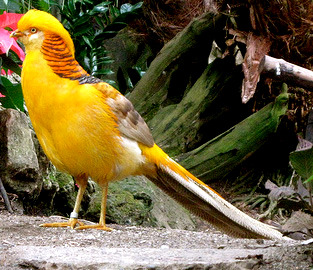 |
Yellow Golden PheasantThe Yelow Golden Pheasant or "Chinese Pheasant", (Chrysolophus pictus) is native to forests in mountainous areas of western China but feral populations have been established in the United Kingdom and elsewhere. The adult male is 90-105 cm in length, its tail accounting for two-thirds of the total length. It is unmistakable with its golden crest and rump and yellow body. Both males and females have yellow legs and yellow bills. Despite the male's showy appearance, these hardy birds are very difficult to see in their natural habitat, which is dense, dark young conifer forests with sparse undergrowth. Although they can fly in short bursts they are quite clumsy in flight and spend most of their time on the ground. Yellow Golden Pheasants lay 8-12 eggs at a time and will then incubate these for around 22–23 days. They tend to eat berries, grubs, seeds and other types of vegetation. |
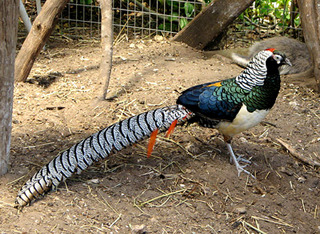 |
Lady Amherst's PheasantThe Lady Amherst's Pheasant, Chrysolophus amherstiae, is a bird of family Phasianidae. These are native to south western China, but have been introduced elsewher in England. The adult male is 100-120 cm in length, its tail accounting for 80 cm of the total length. It is unmistakable with its black and silver head, long grey tail and rump, and red, blue, white and yellow body plumage. This species is closely related to the Golden Pheasant and the introduced populations in England will interbreed. The female is much less showy, with a duller mottled brown plumage all over, similar to that of the female Common Pheasant but with finer barring. She is very like the female Golden Pheasant. Despite the male's showy appearance, these birds are very difficult to see in their natural habitat, which is dense, dark forests with thick undergrowth. Consequently, little is known of their behaviour in the wild. They feed on the ground on grain, leaves and invertebrates, but roost in trees at night. Whilst they can fly, they prefer to run, but if startled they can suddenly burst upwards at great speed, with a distinctive wing sound. |
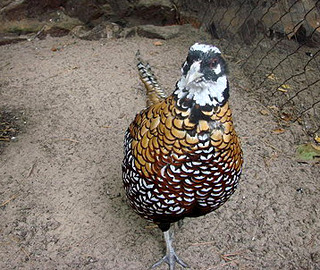 |
Reeve's PheasantReeves's pheasant occupies a fragmented distribution across the mountainous areas of central and east China, and has also been introduced to Hawaii and various parts of Europe. Reeves's pheasant aggregates into flocks of ten or more in autumn and winter, and breaking up in March with the onset of the breeding season. This pheasant is thought to be primarily monogamous. Females lay six to ten eggs into a nest on the ground, usually under bushes or in grass. Incubation lasts 24 to 25 days and is performed by the female alone. It has bright golden-chestnut upper parts, with black borders to each feather creating a strongly scaled appearance, while the upper breast is darker chestnut to black, and the lower breast and side feathers are white, tipped in black. The male's tremendously long orange-buff tail is conspicuously barred with black and white, and the head and neck are white, encircled with a distinctive black mask across the eyes and a black collar around the neck. It is omnivorous bird eating fruits, seeds, buds, fresh leaves, flowers and some insects, snails and earthworms. |
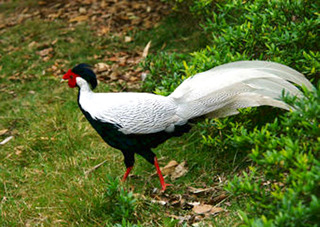 |
Silver PheasantThe Silver Pheasant, Lophura nycthemera is a large, approximately 125 cm long, white pheasant with bare red facial skin, red legs and glossy black below. The male is adorned with white, long, patterned tail and black dropping crest on its crown. At least two years are needed to attain full male plumage. The female is an olive brown with black-tipped crest. The Silver Pheasant inhabits the mountain forests of mainland Southeast Asia and China. |
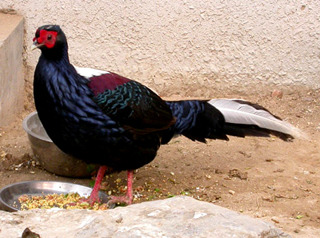 |
Swinhoe's PhasantSwinhoe's Pheasant, Lophura swinhoii, is a bird of the pheasant subfamily of Phasianidae family that is endemic to Taiwan It is commonly referred to as the unofficial "national bird" of Taiwan. The Swinhoe's pheasant cock is a spectacular bird, boasting a glossy black plumage with brilliant metallic blue lustre, and a bold and distinctive pattern of white patches on the upper back, crest and long central tail feathers. The shoulders are a dark, shimmering maroon, and conspicuous crimson-red legs and face wattles inject a splash of vibrant colour. The breeding season lasts from March until July. The female lays 2-6 eggs which are incubated for 25–28 days. The young can leave the nest from 2–3 days. Swinhoe's pheasants have a varied diet, including acorns, berries, flower buds, leaves and other plant material, as well as a few earthworms, millipedes, termites and other insects. |



